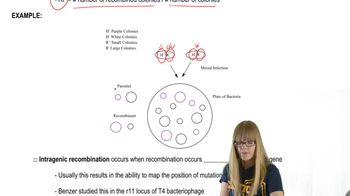Table of contents
- 1. Introduction to Genetics51m
- 2. Mendel's Laws of Inheritance3h 37m
- 3. Extensions to Mendelian Inheritance2h 41m
- 4. Genetic Mapping and Linkage2h 28m
- 5. Genetics of Bacteria and Viruses1h 21m
- 6. Chromosomal Variation1h 48m
- 7. DNA and Chromosome Structure56m
- 8. DNA Replication1h 10m
- 9. Mitosis and Meiosis1h 34m
- 10. Transcription1h 0m
- 11. Translation58m
- 12. Gene Regulation in Prokaryotes1h 19m
- 13. Gene Regulation in Eukaryotes44m
- 14. Genetic Control of Development44m
- 15. Genomes and Genomics1h 50m
- 16. Transposable Elements47m
- 17. Mutation, Repair, and Recombination1h 6m
- 18. Molecular Genetic Tools19m
- 19. Cancer Genetics29m
- 20. Quantitative Genetics1h 26m
- 21. Population Genetics50m
- 22. Evolutionary Genetics29m
5. Genetics of Bacteria and Viruses
Bacteriophage Genetics
Problem 10
Textbook Question
Describe the differences between genetic complementation and recombination as they relate to the detection of wild-type lysis by a mutant bacteriophage.
 Verified step by step guidance
Verified step by step guidance1
Understand the concept of genetic complementation: Genetic complementation occurs when two different mutations in the genome of an organism (or virus, in this case) are brought together in the same cell, and the functional product of one mutation compensates for the defect caused by the other mutation. This allows the organism or virus to exhibit a wild-type phenotype, such as lysis in bacteriophages.
Understand the concept of recombination: Recombination involves the physical exchange of genetic material between two DNA molecules, resulting in new combinations of alleles. In bacteriophages, recombination can produce a wild-type genotype by combining non-mutated regions from two mutant genomes.
Relate complementation to wild-type lysis detection: In the case of bacteriophages, complementation can be tested by co-infecting a bacterial host with two mutant phages. If the mutations affect different genes, the phages can complement each other, leading to wild-type lysis of the host cell.
Relate recombination to wild-type lysis detection: Recombination can be detected by co-infecting a bacterial host with two mutant phages and analyzing the progeny phages. If recombination occurs, some progeny may inherit a wild-type genotype, leading to wild-type lysis of the host cell.
Compare the mechanisms: Complementation involves functional interaction between gene products without altering the genetic material, while recombination physically alters the genetic material to produce new genotypes. Both processes can result in wild-type lysis, but they are fundamentally different in their mechanisms and detection methods.
 Verified video answer for a similar problem:
Verified video answer for a similar problem:This video solution was recommended by our tutors as helpful for the problem above
Video duration:
2mPlay a video:
Was this helpful?
Key Concepts
Here are the essential concepts you must grasp in order to answer the question correctly.
Genetic Complementation
Genetic complementation occurs when two different mutations in a gene are present in the same organism, and the wild-type phenotype is restored. This process is often used to determine whether two mutations affect the same gene or different genes. In the context of bacteriophages, complementation can help identify whether a mutant phage can produce wild-type lysis when paired with another phage carrying a functional copy of the gene.
Recommended video:
Guided course

Complementation
Recombination
Recombination is a genetic process where genetic material is exchanged between different DNA molecules, leading to new combinations of alleles. In bacteriophages, recombination can occur during co-infection of a host cell by two different phages, resulting in progeny that may exhibit wild-type characteristics if the exchanged genetic material includes functional genes. This process is crucial for understanding genetic diversity and the evolution of phages.
Recommended video:
Guided course

Recombination after Single Strand Breaks
Bacteriophage Lysis
Bacteriophage lysis refers to the process by which a bacteriophage infects a bacterial cell and ultimately causes its destruction, releasing new phage particles. The ability of a phage to induce lysis is often used as a measure of its virulence and functionality. In experiments involving mutants, observing lysis can indicate whether the mutations affect essential lytic functions, which can be analyzed through complementation and recombination studies.
Recommended video:
Guided course

Mapping Bacteriophages

 3:44m
3:44mWatch next
Master Plaques and Experiments with a bite sized video explanation from Kylia
Start learningRelated Videos
Related Practice
Textbook Question
In this chapter, we have focused on genetic systems present in bacteria and on the viruses that use bacteria as hosts (bacteriophages). In particular, we discussed mechanisms by which bacteria and their phages undergo genetic recombination, which allows geneticists to map bacterial and bacteriophage chromosomes. In the process, we found many opportunities to consider how this information was acquired. From the explanations given in the chapter, what answers would you propose to the following questions?How do we know that intergenic exchange occurs in bacteriophages?
377
views
